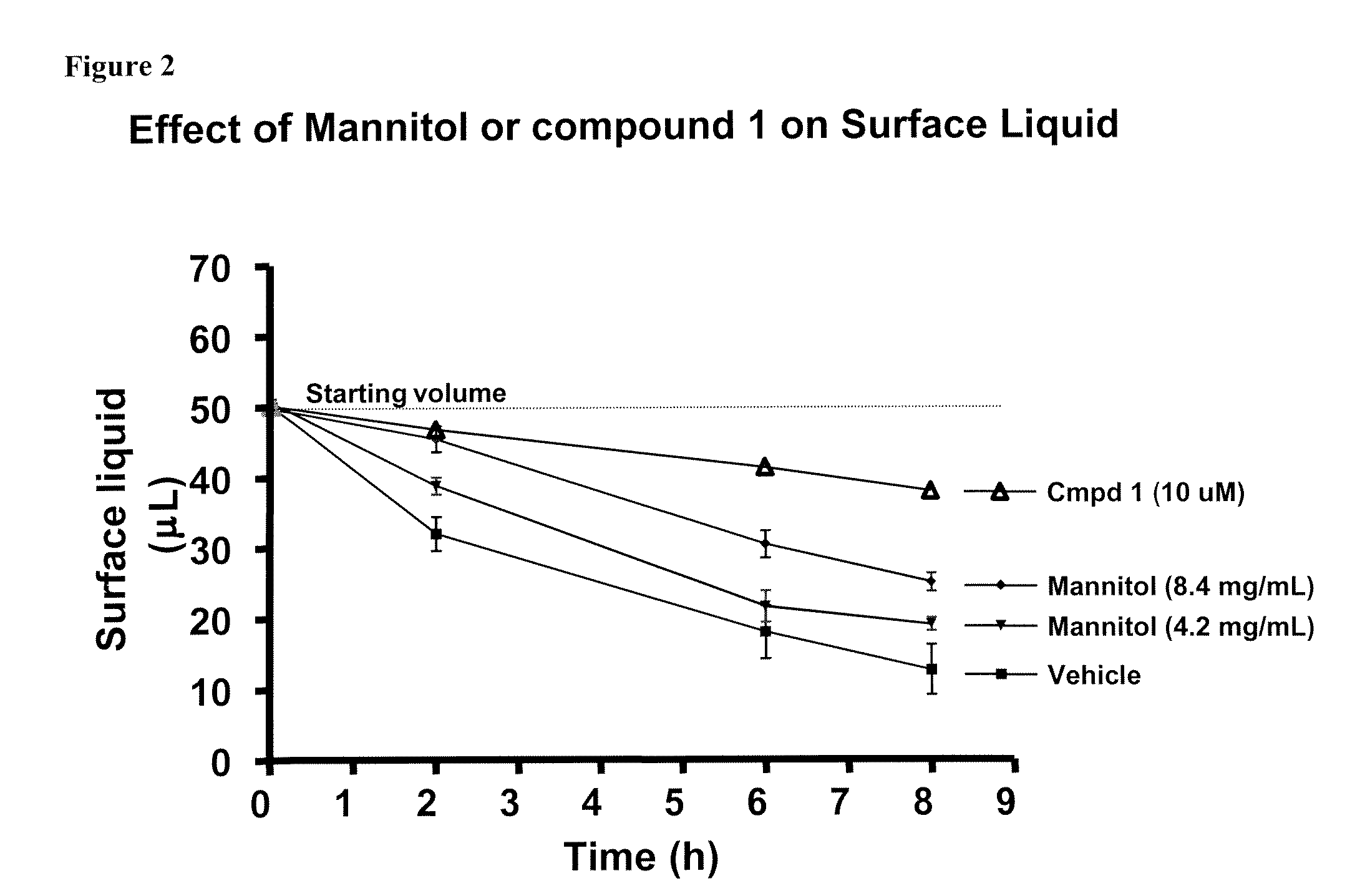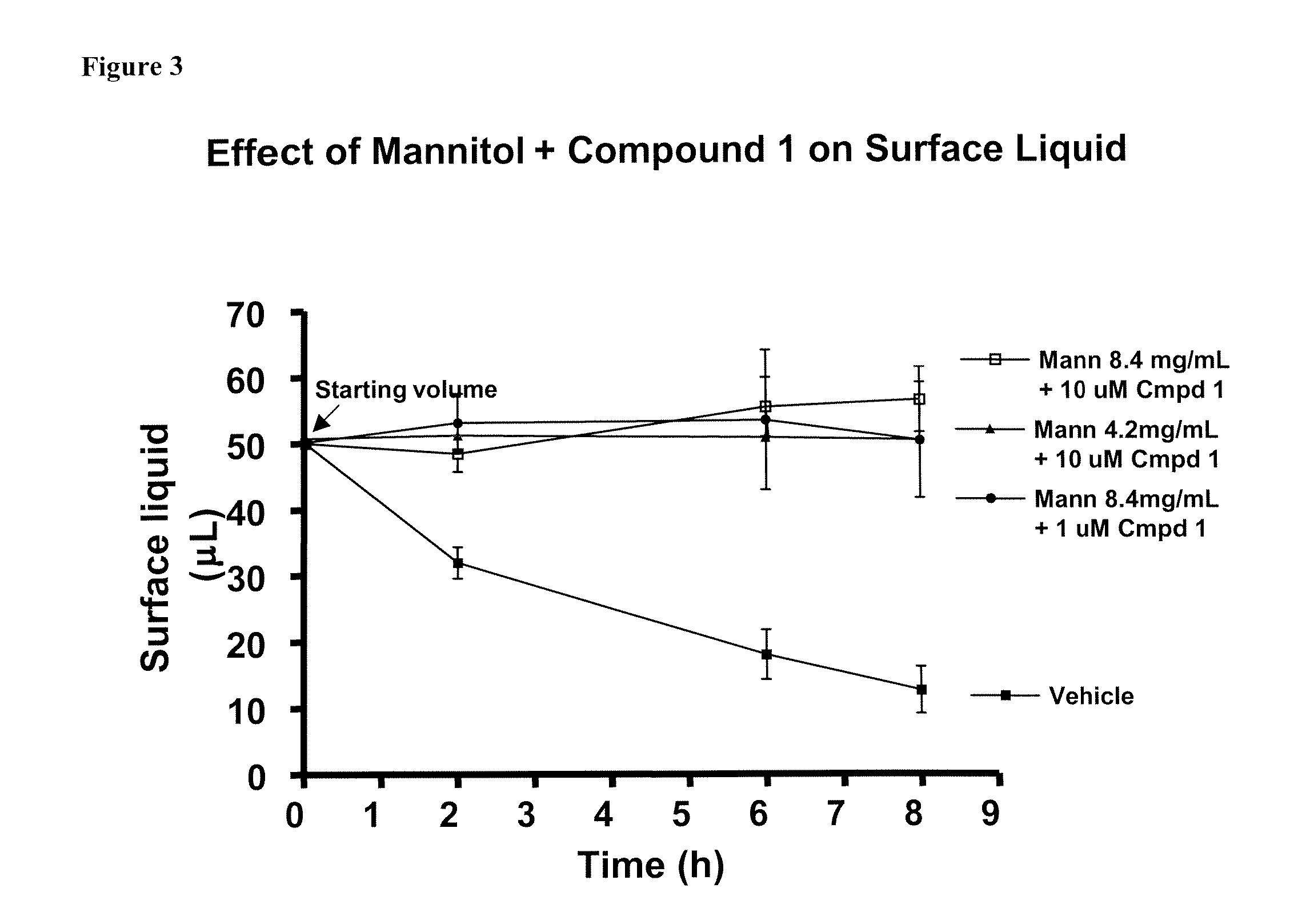Methods of enhancing mucosal hydration and mucosal clearance by treatment with sodium channel blockers and osmolytes
a technology of sodium channel blocker and osmolytes, which is applied in the direction of antibacterial agents, drug compositions, sexual disorders, etc., can solve the problems of inability to clear mucus from airway surfaces, inability to clear mucus, so as to achieve less reversible, less reversible, and more specific
- Summary
- Abstract
- Description
- Claims
- Application Information
AI Technical Summary
Benefits of technology
Problems solved by technology
Method used
Image
Examples
example 1
Preparation of Sodium Channel Blockers
[0180]Materials and Methods. All reagents and solvents were purchased from Aldrich Chemical Corp. and used without further purification. NMR spectra were obtained on either a Bruker WM 360 (1H NMR at 360 MHz and 13C NMR at 90 MHz) or a Bruker AC 300 (1H NMR at 300 MHz and 13C NMR at 75 MHz). Flash chromatography was performed on a Flash Elute™ system from Elution Solution (PO Box 5147, Charlottesville, Va. 22905) charged with a 90 g silica gel cartridge (40M FSO-0110-040155, 32-63 μm) at 20 psi (N2). GC-analysis was performed on a Shimadzu GC-17 equipped with a Heliflex Capillary Column (Alltech); Phase: AT-1, Length: 10 meters, ID: 0.53 mm, Film: 0.25 micrometers. GC Parameters: Injector at 320° C., Detector at 320° C., FID gas flow: H2 at 40 ml / min., Air at 400 ml / min. Carrier gas: Split Ratio 16:1, N2 flow at 15 ml / min., N2 velocity at 18 cm / sec. The temperature program is 70° C. for 0-3 min, 70-300° C. from 3-10 min, 300° C. from 10-15 min.
[...
example 2
[0191]To measure the effects of novel sodium channel blockers with or without osmotically active agents on surface liquid volume on airway surface liquid an in vitro cell culture model was used as described above, Assay #4. The effects of an ionic osmolyte, 1.5% NaCl (hypertonic saline), with or without 10 μM of compound 1 before and after adding 1.5% NaCl and compared it to isotonic buffer (vehicle) (FIG. 1) on surface liquid volume was measured over 8 hours. Using the same method (Assay #4) the effects of a non-ionic osmolyte mannitol at 4.2 and 8.4 mg / mL were compared to compound 1 and isotonic buffer (vehicle) (FIG. 2), and also by combining mannitol (4.2 and 8.4 mg / mL) with compound 1 at 1 and 10 μM (FIG. 3) on surface liquid volume was measured. The effects of compound 2 with an ionic osmolyte, 1.5% NaCl (hypertonic saline), was compared to compound 1 and hypertonic saline (1.5% NaCl), compound 1 in isotonic buffer, compound 2 in isotonic buffer, 1.5% NaCl, and isotonic buffer...
example 3
[0196]A pathophysiological model of CF lung disease based on the abnormal epithelial ion channel defects (CFTR and ENaC), describes depletion of airway surface liquid (ASL) that results in reduced mucociliary clearance (MCC) as the primary cause for chronic respiratory infections. Recently, an aerosol therapy consisting of 7% hypertonic saline three to four times a day in CF patients has been shown to be safe, to transiently increase ASL, enhance MCC, and improve lung function.1,2 The hypothesis that inhibiting sodium absorption using Compound 1 described above, combined with hypertonic saline, would significantly improve duration of action of hypertonic saline by prolonging the increased ASL volume was tested. Primary canine bronchial epithelia (CBE) were grown at an air-liquid interface on permeable membrane supports and a gravimetric method was used to measure changes in volume of buffer on the surface of the epithelium. After adding 50 μL of isotonic buffer to the apical surface...
PUM
| Property | Measurement | Unit |
|---|---|---|
| volume | aaaaa | aaaaa |
| weight | aaaaa | aaaaa |
| weight | aaaaa | aaaaa |
Abstract
Description
Claims
Application Information
 Login to View More
Login to View More - R&D
- Intellectual Property
- Life Sciences
- Materials
- Tech Scout
- Unparalleled Data Quality
- Higher Quality Content
- 60% Fewer Hallucinations
Browse by: Latest US Patents, China's latest patents, Technical Efficacy Thesaurus, Application Domain, Technology Topic, Popular Technical Reports.
© 2025 PatSnap. All rights reserved.Legal|Privacy policy|Modern Slavery Act Transparency Statement|Sitemap|About US| Contact US: help@patsnap.com



